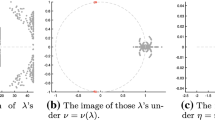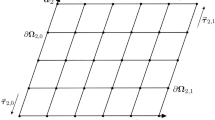Abstract
Band structure calculation of frequency dependent photonic crystals has important applications. The associated eigenvalue problem is nonlinear and the development of convergent numerical methods is challenging. In this paper, we formulate the band structure problem as the eigenvalue problem of a holomorphic Fredholm operator function of index zero. Lagrange finite elements are used to discretize the operators. The convergence of the eigenvalues is proved using the abstract approximation theory for holomorphic operator functions. Then a spectral indicator method is developed to practically compute the eigenvalues. Numerical examples are presented to validate the theory and show the effectiveness of the proposed method.







Similar content being viewed by others
References
Axmann, W., Kuchment, P.: An efficient finite element method for computing spectra of Photonic and Acoustic band-gap materials I. Scalar Case. J. Comput. Phys. 150, 468–481 (1999)
Bart, H., Gohberg, I., Kaashoek, M., Ran, A.: A state space approach to canonical factorization with applications. Birkhäuser Verlag, Basel (2010)
Beyn, W.J., Latushkin, Y., Rottmann-Matthes, J.: Finding eigenvalues of holomorphic Fredholm operator pencils using boundary value problems and contour integrals. Int. Equ. Oper. Theor. 78(2), 155–211 (2014)
Boffi, D., Conforti, M., Gastaldi, L.: Modified edge finite elements for photonic crystals. Numer. Math. 105, 249–266 (2006)
Dobson, D.C.: An efficient method for band structure calculations in 2D photonic crystals. J. Comput. Phys. 149, 363–376 (1999)
Effenberger, C., Kressner, D., Engström, C.: Linearization techniques for band structure calculations in absorbing photonic crystals. Internat. J. Numer. Methods Eng. 89(2), 180–191 (2012)
Engström, C.: On the spectrum of a holomorphic operator-valued function with applications to absorptive photonic crystals. Math. Models Methods Appl. Sci. 20, 1319–1341 (2010)
Engström, C., Langer, H., Tretter, C.: Rational eigenvalue problems and applications to photonic crystals. J. Math. Anal. Appl. 445(1), 240–279 (2017)
Engström, C., Torshage, A.: Accumulation of complex eigenvalues of a class of analytic operator functions. J. Funct. Anal. 275(2), 442–477 (2018)
Engström, C., Torshage, A.: Spectral properties of conservative, dispersive, and absorptive photonic crystals. GAMM-Mitt. 41 (2018), no. 3, e201800009
Figotin, A., Godin, Y.A.: The computation of spectra of some 2D photonic crystals. J. Comput. Phys. 136, 585–598 (1997)
Gong, B., Sun, J., Turner, T., Zheng, C.: Finite element approximation of the nonlinear transmission eigenvalue problem for anisotropic media. (2019), arXiv:2001.05340
Gohberg, I., Leiterer, J.: Holomorphic operator functions of one variable and applications. Birkhäuser Verlag, Basel (2009)
Gu, B.Y., Zhao, L.M., Hsue, Y.C.: Applications of the expanded basis method to study the properties of photonic crystals with frequency-dependent dielectric functions and dielectric losses. Phys. Lett. A 355, 134–141 (2006)
Güttel, S., Tisseur, F.: The nonlinear eigenvalue problem. Acta Numer. 26, 1–94 (2017)
Ho, K.M., Chan, C.T., Soukoulis, C.M.: Existence of a photonic gap in periodic dielectric structures. Phys. Rev. Lett. 65, 3152–3155 (1990)
Huang, R., Struthers, A., Sun, J., Zhang, R.: Recursive integral method for transmission eigenvalues. J. Comput. Phys. 327, 830–840 (2016)
Huang, R., Sun, J., Yang, C.: Recursive integral method with Cayley transformation. Numer. Linear Algebra Appl. 25(6), e2199 (2018)
Huang, R., Sun, J., Yang, C.: A multilevel spectral indicator method for eigenvalues of large non-Hermitian matrices. CSIAM Trans. Appl. Math. 1(3), 463–477 (2020)
Ito, T., Sakoda, K.: Photonic bands of metallic systems: II Features of surface plasmon polaritons. Phys. Rev. B 64, 045117 (2001)
Johnson, S.G., Joannopoulos, J.D.: Block-iterative frequency-domain methods for Maxwell’s equations in a plane wave basis. Opt. Express 8, 173–190 (2001)
Karma, O.: Approximation in eigenvalue problems for holomorphic Fredholm operator functions. I. Numer. Funct. Anal. Optim. 17(3–4), 365–387 (1996)
Karma, O.: Approximation in eigenvalue problems for holomorphic Fredholm operator functions: II (Convergence rate). Numer. Funct. Anal. Optim. 17(3–4), 389–408 (1996)
Kuchment, P.: Floquet Theory for Partial Differential Equations. Birkhauser Verlag, Basel (1993)
Kuzmiak, V., Maradudin, A.A., Pincemin, F.: Photonic band structures of two-dimensional systems containing metallic components. Phys. Rev. B 53, 836–844 (1994)
Kuzmiak, V., Maradudin, A.A.: Photonic band structures of two-dimensional systems fabricated from rods of a cubic polar crystal. Phys. Rev. B 55, 4298–4311 (1997)
Kuzmiak, V., Maradudin, A.A.: Distribution of electromagnetic field and group velocities in two-dimensional periodic systems with dissipative metallic components. Phys. Rev. B. 7130–7251 (1998)
Mackey, D.S., Mackey, N., Mehl, C., Mehrmann, V.: Vector spaces of linearizations for matrix polynomials. SIAM J. Matrix Anal. Appl. 28(4), 971–1004 (2006)
Mehrmann, V., Voss, H.: Nonlinear eigenvalue problems: a challenge for modern eigenvalue methods. GAMM Mitt. Ges. Angew. Math. Mech. 27(2), 121–152 (2004)
Mennicken, R., Möller, M.: Non-self-adjoint boundary eigenvalue problems. North-Holland Mathematics Studies, 192. North-Holland Publishing Co., Amsterdam, (2003)
Norton, R., Scheichl, R.: Convergence analysis of planewave expansion methods for Schröedinger operators with discontinuous periodic potentials. SIAM J. Numer. Anal. 47(6), 4356–4380 (2010)
Pendry, J.B., Bell, P.M.: Transfer matrix techniques for electromagnetic waves, NATO ASI Series E: Applied Sciences, vol. 315. Kluwer, Dordrecht (1996)
Qiu, M., He, S.: A nonorthogonal finite-difference time-domain method for computing the band structure of a two-dimensional photonic crystal with dielectric and metallic inclusions. J. Appl. Phys. 87, 8268–8275 (2000)
Raman, A., Fan, S.: Photonic band structure of dispersive metamaterials formulated as a Hermitian eigenvalue problem. Phys. Rev. Lett. 104, 087401 (2010)
Ruhe, A.: Algorithms for the nonlinear eigenvalue problem. SIAM J. Numer. Anal. 10, 674–689 (1973)
Sakoda, K.: Optical Properties of Photonic Crystals. Springer, Berlin (2001)
Sleijpen, G.L., Booten, G.L., Fokkema, D.R., van der Vorst, H.A.: Jacobi-Davidson type methods for generalized eigenproblems and polynomial eigenproblems. BIT 36(3), 595–633 (1996)
Spence, A., Poulton, C.: Photonic band structure calculations using nonlinear eigenvalue techniques. J. Comput. Phys. 204, 65–81 (2005)
Sun, J., Zhou, A.: Finite element methods for eigenvalue problems. CRC Press, Taylor & Francis Group, Boca Raton (2016)
Toader, O., John, S.: Photonic band gap enhancement in frequency-dependent dielectrics. Phys. Rev. E 70, 046605 (2004)
Voss, H.: An Arnoldi method for nonlinear eigenvalue problems. BIT 44, 387–401 (2004)
Xiao, W., Gong, B., Sun, J., Zhang, Z.: A new finite element approach for the Dirichlet eigenvalue problem. Appl. Math. Lett. 105, 106295 (2020)
Xiao, W., Sun, J.: A novel computational method for band structures of dispersive photonic crystals. arXiv:2010.01603, (2020)
Acknowledgements
The research of B. Gong is supported partially by China Postdoctoral Science Foundation Grant 2019M650460. The research of Z. Zhang is supported partially by the National Natural Science Foundation of China grants NSFC 11871092, NSAF U1930402 and NSFC 11926356. All data generated or analyzed during this study are included in this published article.
Author information
Authors and Affiliations
Corresponding author
Ethics declarations
Conflict of interest
There is no conflict of interests that we aware of.
Additional information
Publisher's Note
Springer Nature remains neutral with regard to jurisdictional claims in published maps and institutional affiliations.
Appendix
Appendix
We present some preliminaries on holomorphic Fredholm operator functions and the abstract approximation theory for the associated eigenvalue problems (see, e.g., [3, 13, 22, 23]). Let X, Y be complex Banach spaces and \(\Omega \subset \mathbb {C}\) be compact and simply connected. Denote by \(\mathcal {L}(X,Y)\) the space of bounded linear operators from X to Y.
Definition 7.1
An operator \(A \in \mathcal {L}(X, Y)\) is said to be Fredholm if
-
1.
The range of A, denoted by \(\mathcal {R}(A)\), is closed in Y;
-
2.
The null space of A, denoted by \(\mathcal {N}(A)\), and the quotient space \(Y/\mathcal {R}(A)\) are finite-dimensional.
The index of A is the integer defined by
Definition 7.2
Let E be a Banach space and \(\Omega \subset \mathbb C\) be an open set. A function \(f: \Omega \rightarrow E\) is called holomorphic if, for each \(w \in \Omega \),
exists.
Let \(T: \Omega \rightarrow \mathcal {L}(X, Y)\) be a holomorphic operator function on \(\Omega \). Denote by \(\Phi _0(\Omega ,\mathcal {L}(X,Y))\) the set of holomorphic Fredholm operator functions of index zero [13]. Assume that \(T \in \Phi _0(\Omega ,\mathcal {L}(X,Y))\), i.e., for each \(\omega \in \Omega \), \(T(\omega ) \in \mathcal {L}(X, Y)\) is a Fredholm operator of index zero. The eigenvalue problem is to find \((\omega ,u)\in \Omega \times X,~u\ne 0\), such that
The resolvent set \(\rho (T)\) and the spectrum \(\sigma (T)\) of T with respect to \(\Omega \) are, respectively, defined as
Throughout the paper, we assume that \(\rho (T)\ne \emptyset \). Then the spectrum \(\sigma (T)\) has no cluster points in \(\Omega \) and every \(\omega \in \sigma (T)\) is an eigenvalue [22].
To approximate the eigenvalues of T, we consider operator functions \(T_n\in \Phi _0(\Omega ,\mathcal {L}(X_n,Y_n))\), \(n\in \mathbb {N}\), such that the following properties hold [3, 22].
-
(b1)
There exist Banach spaces \(X_n,Y_n\), \(n\in \mathbb {N}\), and linear bounded mappings \(p_n\in \mathcal {L}(X,X_n)\), \(q_n\in \mathcal {L}(Y,Y_n)\) such that
$$\begin{aligned} \lim \limits _{n \rightarrow \infty }\Vert p_n v\Vert _{X_n}=\Vert v\Vert _X,\, v\in X,\quad \lim \limits _{n \rightarrow \infty }\Vert q_n v\Vert _{Y_n}=\Vert v\Vert _Y,\, v\in Y. \end{aligned}$$ -
(b2)
The sequence \(\{T_n(\cdot )\}_{n \in \mathbb {N}}\) satisfies
$$\begin{aligned} \Vert T_n(\omega )\Vert < \infty \quad \text {for all } \omega \in \Omega , n \in \mathbb {N}. \end{aligned}$$ -
(b3)
\(\{T_n(\omega )\}_{n \in \mathbb {N}}\) approximates \(T(\omega )\) for every \(\omega \in \Omega \), i.e.,
$$\begin{aligned} \lim _{n \rightarrow \infty } \Vert T_n(\omega )p_n x - q_n T(\omega ) x\Vert _{Y_n} = 0 \quad \text {for all } x \in X. \end{aligned}$$ -
(b4)
Let \(\omega \in \Omega \) and \(\{x_n\} \subset X_n, n\in \mathbb {N}\) be bounded. For any subsequence \(\{x_n\}\), \(n\in N \subset \mathbb N\),
$$\begin{aligned} \lim _{\mathbb {N} \ni n\rightarrow \infty } \Vert T_n(\omega ) x_n - q_n y\Vert _{Y_n}=0 \end{aligned}$$for some \(y\in Y\), there exists a subsequence \(N' \subset N\) and an element \(x\in X\) such that
$$\begin{aligned} \lim \limits _{N' \ni n\rightarrow \infty } \Vert x_n-p_n x\Vert _{X_n}=0. \end{aligned}$$
If the above conditions are satisfied, one has the following abstract approximation result (see Section 2 of [23] or Theorem 2.10 of [3]).
Theorem 7.3
Assume that (b1)-(b4) hold. For any \(\omega \in \sigma (T)\) there exists \(n_0\in \mathbb {N}\) and a sequence \(\omega _n\in \sigma (T_n), n\ge n_0\), such that \(\omega _n\rightarrow \omega \) as \(n\rightarrow \infty \). Furthermore, letting \(G(\omega )\) be the generalized eigenspace of \(\omega \) and \(r_0\) be the maximum rank of eigenvectors associated to \(\omega \), it holds that
where
for sufficiently small \(\delta > 0\).
Rights and permissions
About this article
Cite this article
Xiao, W., Gong, B., Sun, J. et al. Finite Element Calculation of Photonic Band Structures for Frequency Dependent Materials. J Sci Comput 87, 27 (2021). https://doi.org/10.1007/s10915-021-01439-6
Received:
Revised:
Accepted:
Published:
DOI: https://doi.org/10.1007/s10915-021-01439-6




